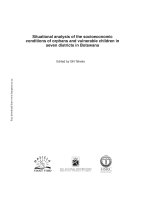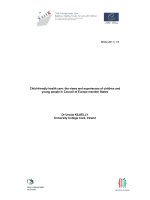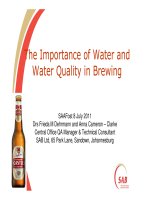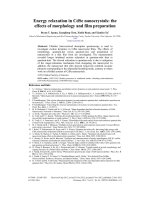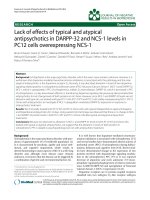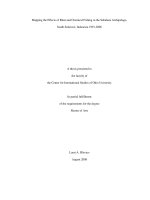Mapping the Effects of Blast and Chemical Fishing in the Sabalana Archipelago, South Sulawesi, Indonesia, 1991-2006
Bạn đang xem bản rút gọn của tài liệu. Xem và tải ngay bản đầy đủ của tài liệu tại đây (3.45 MB, 151 trang )
Mapping the Effects of Blast and Chemical Fishing in the Sabalana Archipelago,
South Sulawesi, Indonesia 1991-2006
A thesis presented to
the faculty of
the Center for International Studies of Ohio University
In partial fulfillment
of the requirements for the degree
Master of Arts
Lauri A. Hlavacs
August 2008
2
This thesis titled
Mapping the Effects of Blast and Chemical Fishing in the Sabalana Archipelago,
South Sulawesi, Indonesia, 1991-2006
by
LAURI A. HLAVACS
has been approved for
the Center for International Studies by
Gene Ammarell
Associate Professor of Sociology and Anthropology
Gene Ammarell
Director, Southeast Asian Studies
Daniel Weiner
Executive Director, Center for International Studies
3
ABSTRACT
HLAVACS, LAURI A., M.A., August 2008, Southeast Asian Studies
Mapping the Effects of Blast and Chemical Fishing in the Sabalana Archipelago, South
Sulawesi, Indonesia, 1991-2006 (151 pp.)
Director of Thesis: Gene Ammarell
The overall purpose of this project was to demonstrate the usefulness and cost
effectiveness of Landsat imagery in mapping reef damage resulting from the use of two
destructive fishing practices, blast and chemical fishing. As a side benefit, the protocol
can be used in educational settings where scientists as well as high school and university
students can map these unsustainable activities over large areas.
The living coral reefs of eastern Indonesia are the most diverse in the world, and
they are also among the most threatened by human activity. The long illegal destructive
fishing practices of chemical and blast fishing have been so widely used that many of the
reefs have been damaged to the point of habitat-wide collapse. This project focuses on
the formerly highly productive reefs surrounding a small chain of islands in the Sabalana
Archipelago, a group of islands located roughly half the distance between the main
Indonesian islands of Sulawesi and Sumbawa.
Habitat-scale change was mapped in four change images between 1991 and 2006
using the increase in relative brightness as the habitat shifted from coral-dominated to
algae-dominated and then to dead coral rubble. The output images illustrated how the
damage spread throughout the area as fishermen using destructive fishing practices
progressively exhausted the resources. The destructive fishing effects were differentiated
4
from larger bleaching events in the characteristic that they resulted in a patchy increase in
brightness over the entire reef. Using this image differencing method, Landsat TM and
ETM+ scanners were shown to be useful and extremely cost effective in mapping the
effects of blast and chemical fishing in the study site.
Approved: _____________________________________________________________
Gene Ammarell
Associate Professor of Sociology and Anthropology
5
ACKNOWLEDGMENTS
Many people have been integral in making this project possible. First, I would
like to thank the Center for Southeast Asian Studies at Ohio University and to the
COTIM program in Manado that provided partial funding for the project. Thank you to
the Center for Coral Reef Studies at Hasanuddin University for allowing me to rent the
research equipment. I would like to thank my thesis committee for all their advice in the
research and writing: Gene Ammarell and James K. Lein from Ohio University and M.
Iqbal Djawad from Hasanuddin University in Indonesia. Many thanks to Jamaluddin
Jompa of Hasanuddin University and David Palandro of the University of South Florida
who provided additional input. A special thank you to Edow Maddusila and Gusti
Hardtiny Kemuning from Hasanuddin University who assisted with the data collection in
the field and interpreting. Thank you to Pak Dula and Pak Hamid, the captains of our
intrepid jolor-turned-dive boat and to the family of Pak Supriady for their hospitality and
who continue to run the research station on Balobaloang Island. Thank you to my
professors and to my friends who helped me through the hard times, especially
Pichayalak Pichayakul (Pang), Elizabeth Collins, Joan Kraynanski, Mark and Kanokwan
(Mai) Mason, Farid Muttaqin, Sandra Nahdar, and Muhammad Chozin. And last but not
least a huge thank you to my family, especially to my parents who patiently supported me
through many setbacks and always believed in me. Without you all, this project would
not have been possible.
6
TABLE OF CONTENTS
Page
ABSTRACT 3
ACKNOWLEDGMENTS 5
LIST OF TABLES 9
LIST OF FIGURES 10
CHAPTER 1. INTRODUCTION 12
CHAPTER 2. DESTRUCTIVE FISHING: CAUSES AND CONSEQUENCES 14
2.1 Motivations: Why do Fishermen Use Destructive Fishing Practices? 19
2.2 Chemical Fishing 27
2.3 Blast Fishing 31
2.4 Ecological Effects of Destructive Fishing Practices 36
2.5 Economic Effects of Destructive Fishing Practices 40
2.6 Social Effects of Destructive Fishing Practices 42
CHAPTER 3. BALOBALOANG ISLAND: A VICTIM OF DESTRUCTIVE FISHING
44
3.1 Academic Work on the Island 50
3.2 Getting There 54
3.3 The Island and the People 56
CHAPTER 4. MARINE APPLICATIONS OF REMOTE SENSING IN MONITORING
REEF DAMAGE FROM BLAST AND CHEMCIAL FISHING 66
4.1 Obstacles to Current Research 67
7
Problems with Current Coral Reef Status Estimates 67
Problems with Reef Status Monitoring 71
Real and Perceived Cost Effectiveness of Satellite Imagery 72
The Advantage of the Landsat Archive 75
4.2 Problems Specific to Remote Sensing in Marine Environments 76
Spatial Resolution Issues 77
Atmospheric and Water Column Attenuation 78
4.3 Using Landsat to Assist in Coral Reef Management Efforts 79
CHAPTER 5. VISUALIZING THE PROBLEM OF DESTRUCTIVE FISHING IN THE
SABALANA ARCHIPELAGO 83
5.1 Digital Change Detection 84
Scale of Investigation of a Highly Complex System 84
Detecting Coral Death from Space 87
5.2 Project Objectives 90
5.3 Methods 92
Image Processing Prior to Field Research 93
Field Data Collection 96
Image Selection 100
Image Differencing 101
Registration 102
Atmospheric and Water Column Corrections 105
Change Detection via Image Differencing of the Blue Band 1 106
8
End User Image Production 107
5.4 Results and Discussion 110
CHAPTER 6. CONCLUSIONS AND RECOMMENDATIONS 113
6.2 Challenges and Other Things to Take into Account 117
6.3 Suggestions for Future Work 120
6.4 Follow the Supply Chain 123
6.5 Take Advantage of the Free Landsat Archive 124
BIBLIOGRAPHY 125
APPENDIX A. RAW DATA USED IN CHAPTER 5 140
Satellite Imagery Profiles 140
Locations of GPS Control Points to Register Images 145
APPENDIX B. RAW TRANSECT DATA 146
APPENDIX C. REEF BALL INFORMATION 151
9
LIST OF TABLES
Page
Table 5.1: Comparison of Landsat TM and ETM+ Scanners 86
Table 5.2: Specifications of Imagery Chosen 100
Table 5.3: Pixel Values for Change Images 107
10
LIST OF FIGURES
Page
Figure 2.1: Patterns of diversity in reef-building scleractinian corals 15
Figure 2.2a: An outcropping of live coral within a large area of rubble 34
Figure 2.2b: Another photo of the same “killing fields” of rubble 34
Figure 3.1: Depth chart of the Sabalana Archipelago 46
Figure 3.2a: Building a lambo on Balobaloang Island, June 2006 49
Figure 3.2b: The lambo we traveled on to the island 49
Figure 3.2c: A smaller fishing boat (jolor) at low tide 49
Figure 3.3: Balobaloang Island is sighted 55
Figure 3.4a: Traditional Bugis style house on Balobaloang Island 58
Figure 3.4b: Modern style house on Balobaloang Island 58
Figure 3.5a: Balobaloang mosque 62
Figure 3.5b: Balobaloang elementary school 62
Figure 3.5a: People walking in the intertidal zone at sunset 65
Figure 3.6b: People walking in the intertidal zone at sunset 65
Figure 3.6c: A sea cucumber (teripang) caught in a tide pool 65
Figure 3.6d: A sea cucumber (teripang) caught in a tide pool 65
Figure 3.6e: A sea urchin caught in a tide pool 65
Figure 3.6f: A puffer fish caught in a tide pool 65
Figure 4.1: Southeast Asian reefs threatened by destructive fishing 70
Figure 4.2: Location of the study area, Landsat bands 3,2,1 in RGB 82
11
Figure 5.1: Reflectance of live vs. dead coral 90
Figure 5.2a: Isodata classified image of the Sabalana Archipelago 95
Figure 5.2b: Subset of potential dive sites 95
Figure 5.2c: The primary field research map 95
Figure 5.3a: Transect locations of observations, natural color, bands 3,2,1 in RGB 98
Figure 5.3b: Transect locations of observations, Isodata classified image 99
Figure 5.4: Change detection map of reef brightness, 1991-2006 109
Figure 6.1: Outline of reef zonation 114
12
CHAPTER 1. INTRODUCTION
Use of the two destructive fishing practices of blast and chemical fishing has led
to extreme reef damage in the most biologically diverse coral reefs in the world located in
eastern Indonesia. Many areas of the world have developed strategies to protect their
reefs, including national marine parks and marine protected areas. These areas are
frequently so large vast that on site monitoring the effects of blast and chemical fishing is
logistically so difficult that it is nearly impossible. With such large areas to monitor,
satellite imagery is the most suitable strategy to detect the effects of these activities.
Newer satellites that produce imagery with high spectral and spatial resolution are very
expensive, whereas both the Thematic Mapper (TM) scanner aboard the Landsat 5
satellite and the Enhanced Thematic Mapper (ETM+) scanner aboard the Landsat 7
satellite produce imagery that is inexpensive and effective for mapping reef loss.
To demonstrate the usefulness of Landsat’s TM and ETM+ scanners in mapping
reef loss resulting from blast and chemical fishing, this project used five images from
1991, 1992, 1995, 1999, and 2006 in an image differencing change detection technique.
Change images were produced between each of the images and combined in one map
which showed reef loss resulting from blast and chemical fishing. Here change was
defined as an increase in brightness between the years which resulted from the death of
symbiotic zooxanthellae (algae) that lives within the corals and gives color to the
animals. The death of the corals that results specifically from blast and chemical fishing
13
is mapped as patchy increases in brightness, rather than broad increases in brightness as
would be seen in large bleaching events as with temperature increases.
For the description of the data collection and analysis, the reader should turn
directly to Chapter 5. Chapters 2 to 4 are devoted to providing an in-depth background on
the use of the two destructive fishing practices, the study site, and marine remote sensing.
Chapter 2 focuses on the motivations of the fishermen for using destructive fishing
practices in general and the ecological, economic, and social consequences of these
activities. It is important to note that destructive fishing has wide ranging effects and does
not only impact the reefs. Chapter 3 gives an overview of the study site and other
academic work done by researchers from Ohio University in Athens, Ohio and
Hasanuddin University in Makassar, Indonesia. In Chapter 4, the problems with current
reef status estimates and monitoring are covered as well as the usefulness of Landsat in
more accurately mapping coral reefs. The final chapter, Chapter 6, gives some
recommendations for future research specific to the research site as well as for Indonesia
in general. The relevant literature is reviewed throughout the introductory chapters,
Chapters 2 through 5, as the various topics are discussed.
14
CHAPTER 2. DESTRUCTIVE FISHING: CAUSES AND CONSEQUENCES
Reefs embody the mixture of the minute and grand,
ephemeral and permanent, simple and complex that we
associate with the natural systems of this planet
(Hatcher, 1997)
Coral reefs are among the most diverse ecosystems, the underwater analogues to
their terrestrial counterparts, the rainforests. Because the efficiency of coral reefs is based
on “recycling of nutrients, [the] net production is actually very low” making them
“poorly suited to large-scale extractive exploitation” (Roberts, 1995). Tropical fish
experience much higher mortality rates than those in temperate regions. Specialist fish
adapted to specific niches within the reef abundant in the tropics are smaller, requiring
more food, than their temperate counterparts (Pauly, 1994, p. 16-19). The coral reef is an
extremely fragile habitat that is too often taken for granted by humans.
Hallock (1997, p.13) described the term reef as, to seafarers, any “submerged
hazard to navigation” which can include those produced by natural (biological and
geological) processes or artificial processes. Reefs can exist anywhere around the world,
but coral reefs are restricted to within roughly 30 degrees of the equator and are made of
a “rigid skeletal structure in which stony corals are major framework constituents.”
Within this paper, the reefs in question are described in as much detail as possible (e.g.
living coral reefs, dead coral reefs, etc).
15
In the past thirty years there has been much discussion about human activities
impacting the health of these communities. Destructive fishing practices (DFPs) defined
by Pet-Soede and Erdmann (1998) include any activity that “results in direct damage to
either the fished habitat or the primary habitat-structuring organisms in the fished habitat
(e.g. [reef building] scleractinian corals in a coral reef fishery)”; such activities include
chemical and blast fishing, anchor damage, trawl fishing, fishing with fine mesh gill nets,
and “weighted scare lines” (Roberts, 1995). The research within this paper will focus on
the first two methods as those are most relevant to the specific coral reef habitat in the
study site, whereas trawling is more applicable to deep water fishing and not used much
in Indonesia. The reefs around Southeast Asia, and in particular the eastern Indonesian
archipelago, are perhaps the most important areas for DFP research because they have not
only the greatest diversity (an area known as the Coral Triangle) but also the most
destructive of human activities (the darkest purple are in Figure 2.1).
Figure 2.1: Patterns of diversity in reef-building scleractinian corals; the study site is in
the area of highest diversity in the world (adapted from Burke et al., 2002, p. 14.)
16
The seas of eastern Indonesia, east of Bali and Borneo (the most eastern islands
before the Wallace Line), are about 20% more diverse than those in the Java Sea in
general, and rare species are much more prevalent. Endemic coral species were found to
make up 25% of the total pool of species sampled. However the variability has dropped,
with now 25% fewer coral genera when compared to those of 1980, and human factors
were suggested to be the reason for the loss (Edinger et al., 2000). The illegal destructive
fishing practices in the region endanger 56% of the region’s reefs (Burke et al., 2002, p.
29), and chemical and blast fishing are more common in parts of eastern Indonesia
(Edinger et al., 2000). These losses are estimated to add to the total loss of the world’s
coral reefs of about 60% by 2030 (Wilkinson, 2000, cited in Spurgeon, 2002).
The coral reef is the home for a wide variety of fish, crustaceans, non-vertebrates,
sea turtles and many other creatures and “are essentially massive deposits of calcium
carbonate that have been produced by corals” (White, 1987, p. 3). Contrary to
misperceptions, corals are not plants. A coral formation is a colony of genetically
identical organisms living together. This organism, referred to as a coral polyp, is related
to jellyfish and can even be thought of as an “upside down” jellyfish, with the stinging
tentacles facing out toward the ocean while searching for food.
What makes the scleractinian (hard, reef-building) corals especially interesting is
that as much as ninety percent of the food it consumes is made from symbiotic
photosynthetic algae called zooxanthellae living within the polyp. So even though the
polyp can consume its food, a large portion is made within (Tomascik et al., 1997, p.
251). In return, the polyp provides the algae with carbon dioxide
as a byproduct of its
17
respiration. This mutually beneficial relationship is the basis for study within this paper;
for without the algae, the polyp cannot live and vice versa. The algae and polyps can be
killed by chemical and blast fishing methods, and in shifting from live to dead, a spectral
brightening occurs which can be detected by satellite imagery. (This will be explored
more fully in the data analysis in Chapter 5.) Scleractinian corals are the creatures that
secrete the calcium carbonate to build up the reefs over time and have a distinctive color
when living.
Anthropogenic (human) activities which cause the death of the zooxanthellae such
as pollution or sedimentation (blocking out the sunlight needed for photosynthesis) are
well known in urban areas (Edinger et al., 1998). However in communities which rely on
the reef ecosystem for their food, there are even more destructive activities killing the
coral during the fishing activities themselves, blast and chemical fishing.
To offset such destructive fishing practices and in planning for future
rehabilitation, researchers have pointed to the need for increased monitoring efforts (Tun
et al., 2004). Only a small portion of reefs are protected by marine protected areas
(MPAs), areas where a management group (either governmental, non-governmental, or
co-managed by both) oversee regulation of human activities within the area for the
purposes of conservation and protection of the natural resources through enforcement of
set local policies. MPAs currently cover “18.7% of the world’s coral reef habitats.”
Though over 40 new MPAs have been created each year over the past 10 years, few are
well managed and little enforcement is present. Only 88 of 980 MPAs (covering 1.6% of
reefs worldwide) are well managed so as to prevent poaching, and “management
18
performance . . . is particularly low in areas of high coral diversity such as the Indo-
Pacific and Caribbean.” Harvesting outside the boundaries of the MPAs with limitations
on fishing, called “no take zones”, can still have a negative effect. Overfishing, pollution,
and sedimentation adjacent to the MPAs can all affect fish populations within the
protected areas (Mora et al., 2006).
In the past, laws against illegal destructive fishing practices in Indonesia were
enforced with the backing of the military under the 40-year Soeharto rule. In the 1960s,
trawling was banned after cutting into catches of traditional fishermen. The small-scale
fishermen retaliated against the trawlers, the press became involved, and the government
intervened, limiting trawling grounds along with permit constraints. When the trawlers
ignored the laws by fishing at night, Soeharto banned them all-out and they disappeared
as he called on his navy to enforce his ruling. This “act of intervention” was not
unwelcome by the fishing communities (Berrill, 1997, p. 60-61). Though trawling is not
covered in this study nor were the laws applied in the area, the strong Indonesian
government enforcement of maritime laws in the past stands in stark contrast with the lax
enforcement of the small scale fishermen using DFPs. With the rise of democratization in
the past decade and weakening of the military, laws protecting fisheries are flaunted by
small scale fishermen who are rarely prosecuted. According to one resident of
Balobaloang Island (personal communication), after Soeharto, conflict over territory and
jurisdiction emerged between the three law enforcement organizations, the water police
(POLAIR), the local police (POLRI) and the navy, leading to difficulties enforcing the
DFP laws.
19
Because of the difficulty enforcing the laws, MPA managers and other
organizations interested in protecting the fisheries must be able to monitor the health of
large scale fisheries. The damage created by DFPs need to be monitored both inside and
outside MPAs. Such monitoring at large habitat-scale levels are most appropriate for
satellite imagery techniques, which is the focus of this paper.
2.1 Motivations: Why do Fishermen Use Destructive Fishing Practices?
A number of theories have been put forth by the academic community to explain
the reasons why fishermen in Southeast Asia use methods that are destructive to the very
resources they rely on for their livelihoods. Many of these theories complement each
other and suggest a variety of factors that together provide an explanation of why
fishermen use destructive fishing practices. I argue that no one factor is sufficient unto
itself, but each is a small piece in a comprehensive explanation for the motivation of DFP
use.
Extreme ecosystem-wide overfishing in the Philippines has been described by
scientists working for the International Center for Living and Aquatic Resources
Management (ICLARM) as Malthusian overfishing, the “logical result of declining catch
per effort (and hence income)” (Pauly et al., 1989). In developing countries fishermen are
among the poorest in the economy and have few possibilities for alternative employment.
Sons enter the profession of their fathers and, together young migrants from farming
20
areas, respond to increasing pressure to feed a population growing unchecked. Both
subsistence and commercial fishing operations effectively destroy the entire ecosystem in
trying to catch more fish with progressively fewer fish available. The fishermen are
subsidized by income from the more mobile daughters who move to work in factories in
cities and then send a portion of their incomes to their brothers and fathers who are
fishermen in coastal communities; this subsidization keeps the fishermen working the
seas, where the income would not normally be able to support them, and they continue
fishing the depleting fish stocks (Pauly, 2008).
When faced by declining fish stocks, traditional fishermen who use line and hook
methods are forced to decide to either change profession (if there are any alternatives) or
to switch to destructive fishing techniques if they hope to make a profit from their
catches. In the study site of Balobaloang Island, there are, in fact, alternatives to fishing
such as inter-island trade and coconut silviculture. Those outsiders who choose to fish
using DFPs cause a shift to smaller fish populations, lower fishery productivity, and
eventually total collapse; scholars point to the increase in use of DFPs as the reason for
the ecosystem collapse (Pauly et al., 1989). The intention in coining the phrase
“Malthusian overfishing” was not to directly link population growth with overfishing;
rather, it was intended to emphasize the point that coastal communities should not be
areas of last resort for those who cannot find employment elsewhere and are not areas
that can produce an increasing amount of goods and services (Pauly, 1994, p. 117).
Malthusian overfishing typically involves “growth, recruitment and ecosystem
overfishing as well as a variety of destructive fishing methods” (McManus, 1997).
21
Growth overfishing is where “fish are caught before they [have] ‘had a chance to grow’”
and is common throughout Southeast Asia; recruitment overfishing is where the numbers
of adult fish are diminished by environmental degradation or overfishing so as to leave
few reproductive individuals to replace the population; and ecosystem overfishing is
where the entire ecosystem is altered and previously abundant populations are not
replaced (Pauly et al., 1989; Pauly, 1994, p. 91-93).
A classic example of recruitment overfishing can be seen in the populations of
grouper (genus Epinephelus of the family Serranidae; Indonesian: ikan kerapu) within the
Coral Triangle. Grouper tend to “spawn in large aggregations at traditional sites during
short time periods” during which “fishermen [who are familiar with such behavior] tend
to catch large numbers of fish over such aggregations,” leading to direct removal of the
reproductively active fish “and thus may have severe detrimental effects on future fishery
yields” as the fish can live up to 100 years (Shapiro, 1987, p. 295 and p. 313). According
to local fishermen from the study site of Balobaloang Island, spawning groupers are
known to be “lazy feeders” during this period and are hard to catch using traditional
fishing methods of lines and bait. It is when these spawning populations are targeted
using blast fishing methods that the adult population is damaged, resulting in recruitment
overfishing (Ammarell, personal communication).
Recent market prices for line-caught fish for local consumption at Paotéré Harbor
in Makassar, Indonesia [using the exchange rate of roughly Rp.9,000 to US$1] for the
local varieties of grouper caught for export have been reported to be between Rp.70,000
(US$7.78) and Rp.300,000 (US$33.33) per kilogram, making a large fish a highly
22
profitable catch and as such, a target for chemical fishing (Chozin, personal
communication). Because blast fishing kills the fish, this method cannot be used to catch
fish intended for shipment for consumption abroad, as they are to be held in live tanks for
fresh preparation in the restaurant. Traditionally these fish were not sold for export, but
dried and sold in port for less money; more recently however, increasing demand and
high market prices make the grouper targets for the international live fish trade (The New
Zealand Herald, 1/25/2007).
Because groupers are sedentary creatures that rely on ambush tactics for feeding,
they are “dependent on a hard substrate habitat” and require spatially complex shelters
“in terms of area, relief, and shelter size” (Parrish, 1987, p. 421) which are frequently
destroyed by blast fishing. Particularly susceptible to disturbances in the environment, the
non-territorial, migratory grouper will move on to a new spawning area if the old one has
been damaged (Wilson and Wilson, 1992, p. 97 and p. 152). Researchers have even
found spatial distribution in other areas to roughly correspond “to the distribution of reef
building corals” (Parrish, 1987, p. 422).
Care must be taken however, not to point the finger at in-migration to coastal
areas as being a significant factor in the increase in the destructive fishing. Cassels et al.
(2005) showed that there is no linear relationship between the size of a coastal population
and the health of the local environment, and that there are factors other than migrant
status that affect resource extraction and use. Though there is a relationship between
“migration and lower environmental quality, i.e., large numbers of migrants live in
villages with poor quality coral reefs,” this does not show causality. They could not draw
23
the conclusion that migration “is directly connected with poor environmental quality via
destructive fishing behavior,” where poor migrants “are incorporated into the fishing
sector rather than the subsistence sector” through either economic methods or
intermarriage. There are no behavior differences between migrants and non-migrants in
damage to the environment; when assimilated into the community, there are no
behavioral differences to suggest that “migrants degrade the coastal environments”
(Cassels et al., 2005). Because of the perception that the fishermen are desperately poor,
their destructive fishing methods are seen as a last resort by those who “pity” the
fishermen (Erdmann, 2001). The number of fishermen actually born in the study site
within this paper is currently not known by the author and would be a topic worth
pursuing within the context of the above migration studies. Though there appears to be
no significant migration to the study site, this is an important point to note as possibly
being applicable to other areas within the Coral Triangle.
In an extension of the population pressure theory of Malthusian overfishing, the
motivation to overfish is simply that, as in “Papua New Guinea, blasting is used as an
economically viable fishing method (myopically speaking) in the midst of what are
perceived to be limitlessly abundant coral seas” (McManus, 1997). This is more likely to
be the motivation among Indonesians than in the Philippines where the research for the
Malthusian overfishing theory was done. This opinion of “limitlessly abundant coral
seas” has also been expressed by fishermen using blast fishing in the study site within
this paper and will be explored further in later chapters (Hapsari, 2008). Similarly, in
other areas (including Balobaloang Island) DFP use is motivated by “’greed rather than
24
need’” as with criminal enterprises, and is protected through corruption throughout the
political network (Erdmann et al., 2002; Thorburn, 2003; Hapsari, 2008).
Blast fishing in fact can be very profitable (if the reef has not already been
destroyed). Divers with medium and large scale operations can make around US$50-$150
per week, more than ten times the average Indonesian laborer (Pet-Soede and Erdmann,
1998). Pet-Soede and Erdmann (1998) suggest that the destructive fishing techniques
may be the preferred method and used first because of the high salaries. They cite a study
that shows small-scale fishermen in Asia as actually being much higher in socio-
economic status, having incomes “often equaling or surpassing national averages” (at
least, before the Asian financial crisis) showing greed as much of a motivation as need.
Furthermore, Subani (1972, p. 80) writes that chemical and blast fishing are
preferred because they are easier and quicker for the fishermen to catch fish in a
relatively short period of time when compared to traditional hook and line fishing. Using
explosives, the fisherman does not need to have any specialized knowledge of fisheries or
other experiences with fishery issues, but only needs the knowledge of how to detonate
an explosive. However, Chozin (2008) has shown that among the small crew of about six
on such an operation, there are a variety of skills used such as spotting schools of fish and
knowledge of timing the detonation so as to target that school.
Furthermore, this trend in pursuing DFP use for profit reflects the Malthusian
Tragedy of the Commons thesis according to which “failure occurs where individuals
seek personal benefit in environmental systems and costs are ‘externalized’ to the group”
in areas where there is no organization of the extraction of resources (Robbins, 2004, p.
25
44). In the case of Balobaloang Island (the area of interest in this study), the fishermen
from Sumanga’ Island who use blast fishing say that they give a portion of the catch to
the people of Balobaloang, and so there is some benefit to the group as a whole (though
one or two fish out of a ton is almost nothing) (Hapsari, 2008). The Tragedy of the
Commons can be thought of as an extension of Malthusian overfishing: the fishermen
who have chosen to continue fishing in the face of declining fishery productivity are
under pressure to catch fish with decreasing resources, thereby using DFPs that damage
the commons in a way that affects the larger population with lower yields, while the
fishermen themselves continue to profit.
According to Paul Robbins, author of Political Ecology, there are two big
problems with the Tragedy of the Commons thesis when applied to marine environments.
The first problem with the thesis is that, in focusing on the people, technology, and laws,
it ignores many of complexities of the biological and reproductive processes of the
fisheries. Fish populations are a result of a large number of factors, only one of which is
predation and fishing. The second criticism of the Tragedy of the Commons is that it
operates in an “open-access environment, free of constraints on entry, with no rules to
govern their behavior and catch.” This is rarely the case, as many communities (such as
in the study site in the Sabalana Archipelago) often have informal, unwritten rules by
which the fishermen operate (Robbins, 2004, p. 153-154) as well as formalized rules of
the national and local government of Indonesia.
The idea that greed is fueling the overfishing is further supported by local
officials who, in taking “protection money,” add to this perception; “for the average

